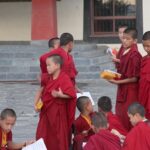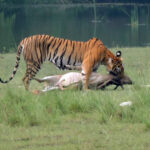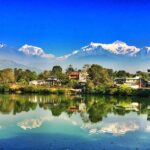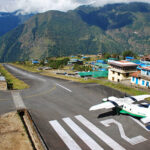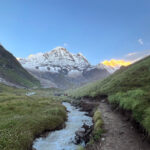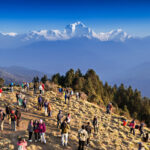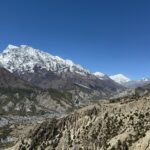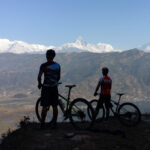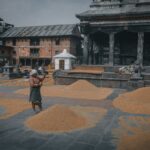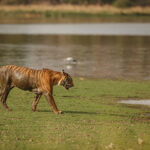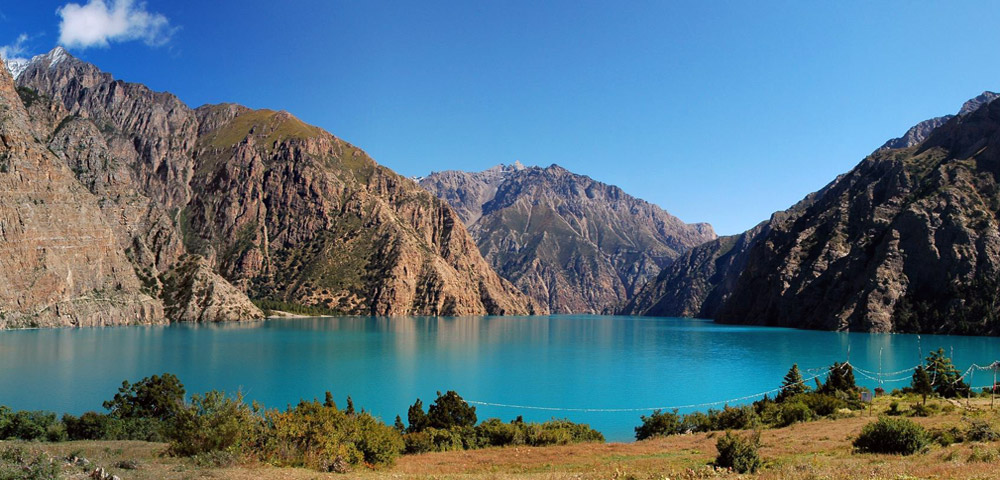
Mountain Lakes in Nepal
Nepal is home to some of the most stunning mountain lakes in the world, each offering unique beauty and a serene escape into nature. These lakes are not only popular trekking destinations but also hold significant cultural and religious importance.
1. Gokyo Lake 4800m
Gokyo Lake, situated in the Everest region of Nepal, is a truly awe-inspiring and tranquil trekking destination in the Himalayas. When you embark on the Gokyo trek, you’ll come across a breathtaking series of crystal-clear, emerald lakes nestled at different elevations. These serene bodies of water form a mesmerizing pattern against the majestic backdrop of towering, snow-covered mountains. The lake system in the Gokyo Valley consists of six main bodies of water, with Thonak Lake being the largest. Experience the unmatched trekking adventure as you immerse yourself in the serene beauty of Gokyo Lake, surrounded by the breathtaking Himalayas.
Travel itinerary
Embark on your adventure to Gokyo Lake by taking a scenic flight from Kathmandu to Lukla, a quaint mountain airstrip that acts as the entrance to the magnificent Everest region. Starting from Lukla, you begin your journey towards Phakding, where you will be staying for your first night. On the following day, you make your way to Namche Bazaar, a lively Sherpa town that serves as the central point of the Everest region. Namche Bazaar offers a wonderful opportunity to acclimate oneself, with a variety of activities to enjoy such as exploring the vibrant local markets, visiting intriguing museums, and embarking on short hikes to nearby viewpoints.
As you leave Namche Bazaar, you’ll be treated to breathtaking views of rhododendron forests. The trail takes you up to Dole and then to Machhermo, allowing you to gradually adjust to the altitude. On the next day, you arrive at Gokyo, which is located at an impressive altitude of around 4,700 meters (15,420 feet). Discover the breathtaking beauty of Gokyo, where you can immerse yourself in the serenity of the lake and embark on an invigorating day hike to Gokyo Ri. This nearby peak presents an unparalleled opportunity to witness the awe-inspiring panoramic vistas that grace the Everest region. At the summit of Gokyo Ri, you can savor the awe-inspiring views of Everest, Lhotse, Makalu, and Cho Oyu.
Once you’ve taken in the breathtaking sights of Gokyo Lake and Gokyo Ri, it’s time to start your descent. The return journey will guide you through Machhermo, Dole, and Namche Bazaar, before ending in Lukla. This itinerary usually covers a duration of 12-14 days, allowing for sufficient time to adjust and explore.
Best time to visit Gokyo Lake
For optimal experiences, consider planning your visit to Gokyo Lake during the pre-monsoon (spring) and post-monsoon (autumn) seasons. During the spring season, which spans from March to May, the weather remains consistent and the rhododendron forests come alive with a burst of vibrant colors, enhancing the beauty of the landscape. This season is perfect for trekking and taking breathtaking photographs, thanks to the clear skies and pleasant temperatures.
Autumn, spanning from September to November, is a fantastic period to embark on a trek to Gokyo Lake. During the post-monsoon season, you can enjoy the beauty of the Himalayan peaks with clear skies, crisp air, and excellent visibility. The weather is usually dry and stable, creating ideal conditions for trekking. During these seasons, the trails are filled with trekkers from all over the globe, but Gokyo is still less crowded compared to the popular Everest Base Camp route, providing a more serene experience.
Overall, Gokyo Lake provides an exceptional trekking experience with its breathtaking beauty and tranquil surroundings. Experience the awe-inspiring trek through Sherpa villages, enchanting rhododendron forests, and breathtaking high-altitude landscapes. The views from Gokyo Ri will leave you speechless, creating memories that will last a lifetime. Whether you decide to visit during the spring or autumn seasons, Gokyo Lake offers a truly breathtaking and fulfilling Himalayan adventure.
2. Tilicho Lake 4919m.
Tilicho Lake, nestled in Nepal’s Annapurna region, stands as a revered destination renowned for its breathtaking beauty and distinction as one of the world’s highest lakes, perched at an impressive altitude of 4,919 meters (16,138 feet). This glacial lake shines like a turquoise jewel amidst the majestic Himalayan backdrop, surrounded by towering peaks including the prominent Tilicho Peak (7,134 meters). The trek to Tilicho Lake promises trekkers an immersive journey through a diverse tapestry of landscapes, from verdant forests and alpine meadows to rugged, challenging trails, all while offering unparalleled views of the Annapurna massif.
Travel Itinerary
Your adventure to Tilicho Lake typically commences with a flight or drive from Kathmandu to Pokhara, followed by a picturesque drive to the trek’s starting point, often Besisahar or Chame, depending on the chosen route. As you traverse through enchanting villages such as Dharapani and Chame, you gradually ascend, treated to ever-changing panoramas of the surrounding landscapes.
Ascending towards Tilicho Lake, the trek winds through lush forests of rhododendron and pine, across swaying suspension bridges spanning lively rivers, and past picturesque villages inhabited by Gurung and Manang communities. Upon reaching Manang, a day for acclimatization is typically scheduled, offering opportunities to explore local culture, visit monasteries, and embark on short hikes to nearby viewpoints.
Continuing from Manang, the journey progresses towards Tilicho Base Camp at approximately 4,150 meters (13,615 feet) above sea level. The final stretch to Tilicho Lake involves a challenging ascent, often navigating through snowy and icy conditions, particularly during transitional seasons. Arriving at Tilicho Lake rewards trekkers with awe-inspiring vistas of deep azure waters mirroring the towering peaks, presenting a breathtaking spectacle of nature’s grandeur.
After soaking in the serene ambiance and capturing unforgettable moments at Tilicho Lake, the return journey retraces your steps through Manang, descending to lower altitudes via villages like Pisang and Tal, before concluding back at Besisahar or Chame. Typically spanning 12-14 days, this trek allows ample time for acclimatization and full appreciation of the region’s natural splendor.
Best time to visit Tilicho Lake
For the optimal trekking experience, consider planning your visit to Tilicho Lake during the pre-monsoon (spring) and post-monsoon (autumn) seasons. Spring (March to May) offers pleasant weather, vibrant blooms of rhododendrons, and clear skies, providing excellent visibility of the mountains and landscapes. It’s an ideal time to witness the area’s colorful flora in full bloom.
Autumn (September to November) boasts stable weather conditions, clear skies, and comfortable daytime temperatures, making it perfect for trekking activities. During this season, trekkers can relish in stunning mountain views and partake in local festivals and cultural events celebrated in villages along the route.
In essence, embarking on a trek to Tilicho Lake promises an unforgettable journey through some of the most breathtaking landscapes in Nepal’s Annapurna region. For adventure enthusiasts seeking both natural beauty and cultural immersion in the Himalayas, Tilicho Lake stands as a captivating destination offering a profound and enriching experience.
3. Phoksundo Lake 3589m.
Phoksundo Lake, situated in Nepal’s remote Dolpo region, boasts stunning turquoise-blue waters and awe-inspiring landscapes. Perched at an impressive altitude of 3,589m, it ranks among the world’s highest lakes and holds profound cultural significance for local Tibetan Buddhists.
Travel Itinerary
Travelers typically commence their journey with a flight from Kathmandu to Nepalgunj, followed by another flight to Juphal, the trek’s starting point. From there, trekkers traverse Dolpo’s challenging terrain, encountering isolated villages, verdant forests, and lofty mountain passes before arriving at the tranquil shores of Phoksundo Lake. The trek spans 8-10 days, allowing ample time for acclimatization and full immersion in the area’s pristine natural beauty.
Best time to visit Phoksundo Lake
The best times to visit Phoksundo Lake are during the clear, mild weather of autumn (September to November) and spring (April to June). Autumn offers crystal-clear views of the lake and surrounding mountains, while spring showcases vibrant wildflowers and lush greenery, enhancing the overall experience.
Exploring Phoksundo Lake firsthand promises a captivating journey of thrilling adventures, breathtaking landscapes, and rich cultural encounters. Whether trekking solo or with a guided tour, visitors can relish in panoramic vistas, serene surroundings, and an intimate glimpse into Dolpo’s traditional way of life. The lake’s mesmerizing blue waters, framed by majestic snow-capped peaks, create an unforgettable spectacle that inspires photographers and leaves an indelible mark on all who visit.

